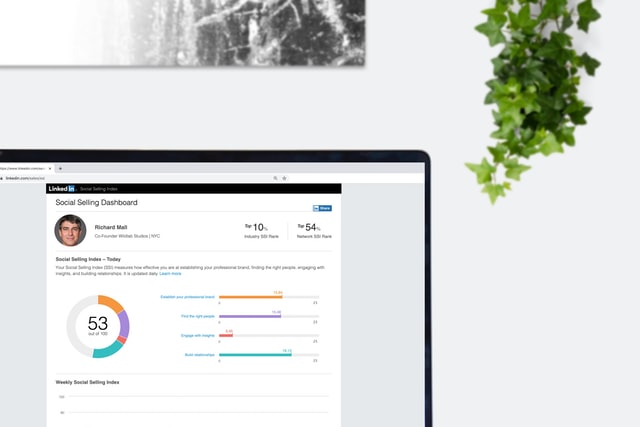When you’re working in B2B sales, one of the most effective ways of generating new leads is with a targeted prospecting list. It’s a tool that can help you understand whom you’re selling to, what influences their decisions, and how you can reach them. Yet the process of how to build a prospect list isn’t always straightforward. To get you started, we take a closer look at understanding your prospects, as well as how you can build a list that’s focused on LinkedIn lead generation.
What is a prospect?
Understanding who your prospects are is an essential part of B2B sales. But what exactly does the term mean? Put simply; a prospect is a potential customer that fits certain criteria. Often, this means they fit into your target market, demographic, or customer persona. They don’t necessarily have to have interacted with your business at any point, but they must show the characteristics of the people who typically do.
A prospect is different from a lead, however. Leads are those who have already shown at least some interest in your product or service. They may not necessarily match your target customer/market, but they have at least taken the first steps to engage with you.
Why prospects are necessary
Prospecting (the method of finding and contacting prospects) is an essential process for just about every business. To be successful, you’ll need to build a database of qualified leads that you can reach out to. But why is this such a vital process?
Firstly, finding prospects keeps your sales pipeline full. This means that you can build a supply of potential customers and decision makers that you can work to progress through your sales process. For salespeople of all kinds, this is of the highest importance. Without it, you’ll struggle to make sales and will have to rely on less effective means of reaching people.
When done correctly, prospecting can also help you increase your conversion rates and closing rates. Clearly, it’s essential to know your prospects and how you can reach them.
Types of prospecting
Prospecting isn’t always easy. In fact, some statistics say that over 40% of salespeople say it’s the most challenging part of the sales process. However, knowing the different types of prospecting can massively help with your lead generation. To give you a headstart, we’ve outlined some of the main types below:
Warm prospecting
Warm prospecting is where you reach out to a company that you’ve identified as a close match to your target market. They won’t have yet demonstrated an interest in your product/service, but they likely will be aware of what you offer. They’ll likely be high on your targeted prospect list.
It’s an effective means of prospecting, as you know that it’s likely to go somewhere. You’ll have done your research, meaning that you’re sure they fit the profile of one of your customers.
To make your warm prospecting as effective as possible, you’ll need to focus on getting as much information about your potential customer as possible. As well as the company itself, you should focus on the executives and work on the perfect opening.
Cold prospecting
Cold prospecting is often a more difficult approach. The person or company you’re contacting will still fit your target audience, but maybe a bit more loosely. They probably won’t have heard of you, and they’ll be lower down your list.
Although cold calling and cold emailing may seem like a fairly outdated technique, it’s still relevant and can be successful. However, you need to put the work in to make it work. You’ll need to demonstrate from the off that your call or email isn’t just another spam message.
When prospecting on LinkedIn, for example, work on crafting a connection request that’s going to instantly grab their attention and provide value to them.
Understanding your prospects
Before we get started with how to build a prospect list, it’s worth mentioning why it’s so important to understand your prospects. Having a handle on their interests, desires, and needs can make the process of moving them through the sales pipeline far easier.
The process of qualifying your prospects means that you have identified whether they’re someone worth talking to. You need to find out whether they need what you’re offering, how badly they need it, whether they can afford to buy from you, and whether they’re the decision-maker.
A lot of this comes down to your research, both generally and specifically. You’ll want to know as much about your target market as possible, as well as the motivations of the individuals you want to reach out to.
With tools like LinkedIn Sales Navigator, you get access to a wide variety of search options. With these, you can narrow down your results, meaning you get prospects that match your criteria.
Understanding your offering
As important as knowing your prospects is, equally essential is understanding your offering. The worst-case scenario is that you reach out to a prospect, only to flounder when they start showing interest in your product/service.
As part of the prospecting process, you should spend time getting to know what you’re offering. Think about the unique selling points, how it can satisfy your customers’ needs, and the types of hurdles people might have to overcome to purchase it.
Gathering and analyzing your data
So, we know that research and analysis plays a central role in how to build a prospect list. Before we get into our step-by-step, let’s focus on the data side of things. There are two things to think about here – where to gather the data and what types to aim for:
Techniques for Gathering Customer and Prospect Data
So, where are some ways that you can gather customer and prospect data? Of course, things like mailing lists are a good place to start, but you knew that already. Some other methods include using:
- Chatbot. These automated tools can help you gather key contact information such as email addresses and phone numbers. This info usually comes from those who visit your website and might be interested in what you’re offering.
- Referrals. Leveraging your existing customer base can be a powerful way of gathering data about new prospects who match your target demographic.
- Checkout form. Many people are willing to input at least some data at checkout, even if they’re not quite committed to buying.
- Surveys. On-site and email surveys can be useful in gathering all kinds of information about your customers and potential leads.
Types of Customer and Prospect Data to Gather
When doing your research, you’ll want to gather as much information as possible about your prospects and customers. Here are some points to focus on:
- Identity data. Contact information and personal data are essential when reaching out to potential customers.
- Descriptive data. This adds a bit more depth to the types of things that might motivate a sale.
- Quantitative data. This data can be used to quickly sort and compare prospects to make sure they match your target market.
- Qualitative data. With this information, you get more insight into their personality.
How to build a prospect list
So, let’s get into how to start building a list of prospects. It’s an essential part of the sales process, and so requires a fair bit of time and dedication. Essentially, you have two options when it comes to building a prospect list:
Building a Prospect List Manually
As you might expect, this is where you delve into the research side of things yourself. On LinkedIn, this means that you’ll have to use a tool such as Sales Navigator and put your social skills to the test.
As well as outlining who your ideal prospects are, you’ll then have to spend some time qualifying them and doing outreach.
Building a Prospect List using Automated Tools
The other option is to use tools to bring more automation to your efforts. These can automatically identify the types of people you should be looking for, as well as the necessary contact information. Zopto is one such tool, offering you the chance to target your ideal customers on LinkedIn.
A step-by-step guide
Below, we’ve outlined the process that you’ll need to go through when you’re building your prospecting list. Although it may vary slightly depending on your organization, the basics remain the same:
Identify your Ideal Customer Profile
Your Ideal Customer Profile (ICP) is designed to help you identify, source, and prioritize your prospects. Essentially, it’s a combination of data and characteristics that creates a general profile of your best accounts. These are more focused on the businesses that you should target, based on the types of customers that you already have.
Identify the buying persona
The buying personal is a slightly different matter to your ICP. Here, you’ll need to instead focus on the types of individuals that are likely to purchase from you. As well as demographic data, you can also take into account buying motivations, interests, and other qualities these individuals possess.
Research & verify
There are several steps you can take here, making sure that the prospects you’ve identified are worthwhile reaching out to. LinkedIn makes this stage fairly easy, as there are several tools designed to help, including the advanced people search. Here are some of the steps you should consider:
- Save leads and prospect user accounts
- Set smart triggers
- Use filters to narrow down the search
- Save time with Sales Spotlight
- Reconnect with old leads with bluebird search
- Utilize the ‘view similar’ feature
- Use TeamLink to identify warm leads
- Drop them an InMail
- Keep your profile optimized
Import into CRM
Once you’ve started to qualify your prospects, it’s time to add them to your CRM software. Here, you can track your progress with them, making sure that warm and hot leads don’t escape you.
Final thoughts
So, there we have, a close look at how to build a prospect list. Clearly, it’s an essential part of the sales process, as it keeps your sales pipeline full of potential clients. LinkedIn and other social media sites can be powerful platforms when it comes to finding and reaching prospects. What’s more, there are many tools that can help you take advantage of these opportunities. By using LinkedIn, you can build a targeted prospect list of decision makers.

